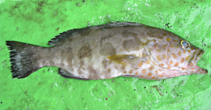| Family: |
Epinephelidae (Groupers) |
| Max. size: |
71 cm TL (male/unsexed); max.weight: 4,539.0 g |
| Environment: |
demersal; marine; depth range 73 - 210 m |
| Distribution: |
Eastern Indian Ocean: Western Australia. Eastern Central Pacific: American Samoa and the Phoenix Islands. |
| Diagnosis: |
Dorsal spines (total): 11-11; Dorsal soft rays (total): 16-17; Anal spines: 3-3; Anal soft rays: 8-8. Preopercle angle with 2 - 4 distinctly enlarged serrae; upper edge of the operculum straight or nearly so; nostrils small, subequal; maxilla extends to below rear half of the eye. Color is pale brownish gray with yellow or golden brown spots on the head, nape and chest. A row of dark yellowish brown spots along the margin of the soft dorsal and anal fins and the rear edge of the caudal fin. Pelvic fins with yellowish brown and whitish streaks and a few yellowish brown spots distally. Further characterized by body depth contained 2.7-3.4 times in SL; head length 2.4-2.7 times in SL; flat to convex interorbital area; 2-4 distinctly enlarged serrae at preoopercle angle; upper edge of operculum nearly straight or straight; small anterior and posterior nostril, subequal; maxilla extends to below rear half of eye; 2 rows of teeth on midlateral part of lower jaw (Ref. 89707). |
| Biology: |
Nothing has been published on the biology of this rare species. The apparent rarity of this species is probably a result of its deep-water habitat and the fact that it was only recently described as a new species. |
| IUCN Red List Status: |
Least Concern (LC); Date assessed: 22 November 2016 Ref. (130435)
|
| Threat to humans: |
harmless |
Source and more info: www.fishbase.org. For personal, classroom, and other internal use only. Not for publication.

